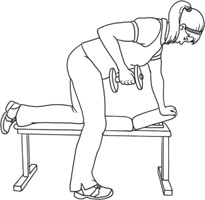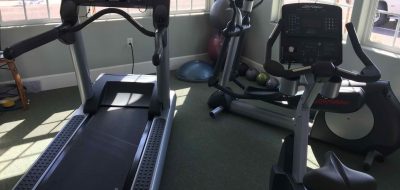By Lynn Difley
When I was young, my grandmother was constantly reminding me to “stand up straight” and loved to challenge us to balance a pillow on our head as we walked across the room. Nowadays posture, or “carriage” as it was referred to in my grandmother’s day, is one of those things that has fallen out of vogue. Maybe because it’s so hard to find. Look around and you see the tell tale signs of a culture that spends far too much time bent over a computer, sewing machine, driving long hours, or protecting themselves from life’s burdens. The hunched shoulders, rounded upper back, head forward look is not only unattractive, it places undue stress on the vertebrae and is often the culprit in lower back problems.
Fear not, poor posture is most often a result of bad habits, and can be corrected. Yes, go get a pillow, place it on top of your head and walk around the room several times. How often did you have to bend over to pick it up? Another way to self-correct your posture is to stand against a wall. Place your heels about 6 inches out from the wall and about 6 inches apart from each other. Keep your weight evenly distributed, arms relaxed at your sides. Keep your ankles straight, feet parallel, kneecaps facing forward. Bring your head back to touch the wall. Tuck your chin and lift the crown of your head. Pull the muscles of the abdomen up and in, to create a natural girdle. Gently straighten the upper back by lifting your chest and bringing your shoulders back and down against the wall. Hold this position while breathing normally. Now step out from the wall and try to maintain this perfect posture position.
 If there is one body movement that is crucial for good posture it is a pulling movement. Generations ago, physical labor involved pulling. Milkmen, farmers, factory workers, and everyday laborers’ occupation involved grabbing a box, barrel, or stack of something, lifting it and transporting it somewhere else. Any movement climbing ladders uses pulling muscles. But nowadays few of us use ladders, or lift anything sizable on a regular basis. So we need to try to correct our posture by performing some pulling movements, which will strengthen the muscles in the upper back. You are also going to have to remind yourself to pull your shoulders down and back, to counteract the times you forget and let them sink forward and climb up around your ears.
If there is one body movement that is crucial for good posture it is a pulling movement. Generations ago, physical labor involved pulling. Milkmen, farmers, factory workers, and everyday laborers’ occupation involved grabbing a box, barrel, or stack of something, lifting it and transporting it somewhere else. Any movement climbing ladders uses pulling muscles. But nowadays few of us use ladders, or lift anything sizable on a regular basis. So we need to try to correct our posture by performing some pulling movements, which will strengthen the muscles in the upper back. You are also going to have to remind yourself to pull your shoulders down and back, to counteract the times you forget and let them sink forward and climb up around your ears.
The most important muscles for posture are the big wedge shaped muscles across the shoulders in the back called trapezius. Strengthening these muscles helps pull the shoulders back and down, resulting in improved posture and a stronger upper body. To strengthen your trapezius use a dumbbell row. Grab a dumbbell or any semblance thereof–frying pan, small dog, large can of beans–in your right hand. Stand with your feet shoulder width apart, knees bent and the left hand behind your back. Pull the weight up to your side- finishing with the elbow up behind. Lower, and repeat 10-15 times. Switch arms and repeat.
A pull up (or chin up) is a well known pulling exercise–most playgrounds still have bars, and lots of trails maintain their parcourse bars. Instructions are easy, grab the bar and lift yourself up as high as you can go, then slowly lower yourself. Repeat.
Here’s a great stretch to undo your gorilla like tightness: sit in a chair with your feet flat on the floor, spine straight. Grab the right edge of the seat with your right hand, and lean to the left as far as you can, keeping your rear on the chair (both cheeks) and pressing down with your right shoulder. Repeat on the other side. So now go get the pillow and try again, haven’t you improved your carriage astoundingly?
And here’s a great visualization to help you remember to keep your shoulders back and down where they serve to maintain perfect posture. Walk and feel like you are superman, with your cape flowing behind you. Or superwoman, of course.




